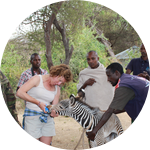Please wait...
About This Project
Grevy’s zebra are one of Africa’s most threatened large mammals. My project focuses on the largest extant Grevy's populations in Kenya, where animals face increasing environmental stress. The project goals are to understand how genetic diversity and environmental stress combine to affect disease risk. Results will inform efforts of Kenyan wildlife officials to mitigate the risk of disease, which they have identified as a major threat to the species' survival.

Browse Other Projects on Experiment
Related Projects
How do polar bears stay healthy on the world's worst diet?
Polar bears survive almost entirely on seal fat. Yet unlike humans who eat high-fat diets, polar bears never...
Uncovering hidden insect diversity associated with a likely undescribed gall-forming midge
Does a likely undescribed species of gall-forming midge (pers. comm. Ray Gagné) on Eriodictyon plants (Yerba...
Macrofungi of the California archipelago
The eight islands of the California Archipelago are a well-studied biodiversity hotspot — but we know almost...




